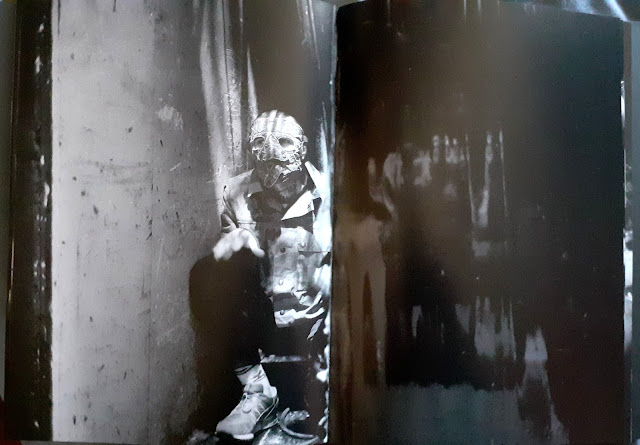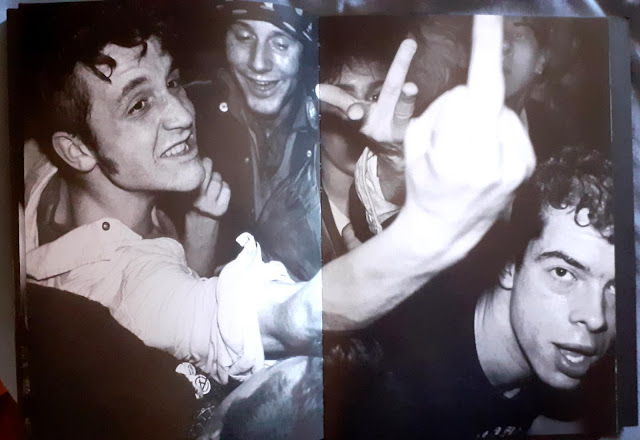After the Punk Rock Jesus comic book, here is my second post about a paper-and-ink-only object, and it's a photobook this time.
Indeed I've decided to write a few words about Pogo (A look at the French punk scene), published in 2019, because I feel it's the kind of book which is probably completely unknown outside of the French speaking world and that for two reasons:
- first and the most obvious: it's in French and published in France, OK.
- second: it focus on a part of the 80s French punk scene which, to my knowledge, has been mostly ignored by the wide world of non-French speaking punk (and for understandable reasons).
As Romain from Terminal Nuisance explained briefly in the introduction of his 2019 French DIY Punk Scene: The Definitive Guide for DiY Conspiracy, the 80s French punk scene was divided in several sub-scenes which were not always mixing. The one covered by Pogo was the most "successful" and "popular" in terms of media coverage and records sales, the one called "punk alternatif" or "rock alternatif" sometimes, the one lead by the band Bérurier Noir. A band whose social and vindictive songs, veritable slogans and hymns to rebellion, continue to accompany numerous demonstrations throughout the country, animating the march of thousands several generations of agités. Far beyond the punk movement, les Bérus became an immovable component of the revolt folklore in France, until now and probably for a long time.
In fact Les Béruriers Noirs were probably the only band which shook down a little bit the youth and music industry of France in the 80s (the proper earthquake would come a bit later with the explosion of French hip hop / rap and bands like N.T.M (Nique Ta Mère, literally Fuck Your Mother, but that's another story).
This scene had a quite original approach to punk rock (quite unique to my knowledge I would say) in a sense that it was not trying to stick to standards established by the British or American scenes but, while getting heavily inspired by all of them of course, to use it as a doorway to "more open" musical ways of expression (reasons why drunk French punk purists may tell you that all this scene had nothing to do with punk in the first place; an old and boring debate...).
Anyway, so this "punk alternatif" scene was at the same time, open, arty, minimalist, radical, messy, burlesque, festive, spontaneous, violent, fun, silly... and a lot of other things as well of course...
I'm talking about bands like Bérurier Noir, Lucrate Milk, Ludwig Von 88, Washington Dead Cats, Nuclear Device, Parabellum, les Wampas, les Garçons Bouchers, OTH, les Shériffs, les Cadavres etc... Some very diverse kinds of bands, not all of which are good and interesting, to say the least...
But this lack of a common artistic line was also an opportunity to welcome a wider audience from a youth that didn't need to adhere to the rigid codes of an elitist and closed punk scene, which partly explains its success. Independence, commitment and revolt were more important than aesthetics.
Roland Cros could be described a self-taught artist who started as a photograph and spent years, in the beginning of the 80s, in the worlds of bullfighting, Rudby and body building before jumping into the Bérurier Noir punk scene.
As he explains at the beginning of Pogo, his "photographic strategy" has always been the same (for all the subjects he's covered): only one camera setting (Leika, 35mm, 24x36 format, no flash, 400 ASA film, no cropping on the print run) and most importantly to spend as much time as needed in the "field" to become "invisible" and be able to "catch the real thing"... and Roland spent 5 years with the Bérurier Noir and their friends...
To his credit, the mind-blowing pictures displayed in this book are an undeniable proof of the success of his method.
Because Roland, in addition to capturing the startling explosion of energy that each concert of the "Bérus" was, also succeeded in portraying the powerful symbiosis that the band has always managed to create with its audience. You can catch a glimpse of it watching Viva Bertaga, the video footage of their last concert in 1989 (before they came back together for a short period twenty years later).
As we all know it, punk rock was built on the destruction of the band/audience border and it was important, in the idea of a thorough "scene coverage", to give a decent space to the audience in a book dedicated to a specific scene.
On top of all the deeply beautiful black and white pictures of Roland, a few "important personalities" of the scene deliver their little write up about the old days.
The two most interesting ones in my opinion (to be honest most of the others are not essential) being the one from Roland, who explains really well his approach and the circumstances of his discovery of the scene, and the one from Marsu, the famous manager of Bérurier Noir (and Lucrate Milk), who knows the story from start to finish.
On top of "thrilling" anecdotes, they both have merit in placing this whole "movement" in a very specific French social political context, the end of the illusions created by the arrival of the left in power in 1981, a policing policy of security and repression, the rise of the national front etc...
Context which is important to keep in mind to understand the specifics of the 80s punk movement in France.
In a nutshell it's a beautiful book (printed on a thick, matt paper, unlike all these books on glossy paper which give a "magazine" appearance), whose pictures talk enough for themselves (they're full page pictures without any text), delivering a moving and powerful testimony on a scene which, I feel, remains quite ignored outside of the French-speaking world borders...
And I can't recommend enough all the punk geeks from around the world to get themselves a copy!
You can check it out here, on the Bérurier Noir label distribution website (Folklore de la Zone Mondiale) or here, on the publisher's website.
After his years in the "punk alternatif" scene, Roland Cros quit photography to focus on other kinds of art expressions.
He draws, sculpts and carves wood.
You can check some of his work HERE.
If you're interested about French punk history, the most thorough (and beautiful) book on this subject is Nyark Nyark, which I strongly recommend (it's in French though...).
It focus on the rock alternatif scene but not only.










Aucun commentaire:
Enregistrer un commentaire